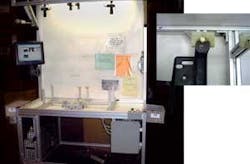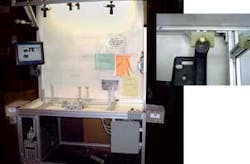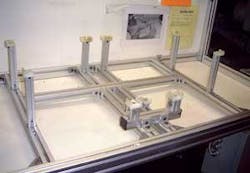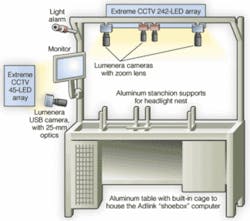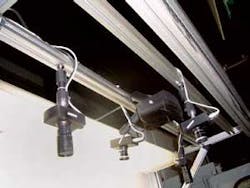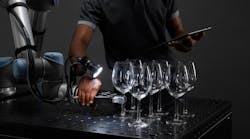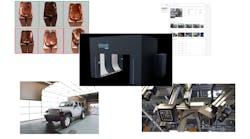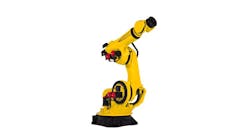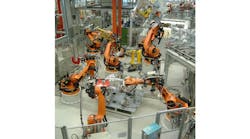Off-the-shelf vision components and software combine with NIR LED lighting to inspect plastic automotive parts.
By R. Winn Hardin, Contributing Editor
The major US automakers require many of their suppliers to provide 100% defect-free products. Facing a choice between 100% part inspection or lengthy audits from the automakers, plastic-injection-molded-part supplier Lawrence Plastics (Orion Township, MI, USA) decided that automatic inspection was the best way to guard against short shots and flash (overfills) in its plastic-headlight-assembly manufacturing lines.
Lawrence turned to plastics machine-vision specialist Avalon Vision Solutions to create an automated inspection system that checks each part as it comes off one of its three injection-molding manufacturing lines. The system uses a pair of Extreme CCTV near-infrared (NIR) LED arrays designed for nighttime security surveillance to illuminate the part and four Lumenera 1080 × 1284-pixel digital CCD cameras tied to an Adlink Technology America “shoebox” computer via USB 2.0 connections. An additional tower alarm, similar to those used in the semiconductor industry, connected to the PC by LVDS indicates pass/fail. The resulting system inspects approximately four regions of interest per camera to make sure parts are 100% defect free (see Fig. 1).
null
Designing for contingencies
Headlight assemblies exit the plastic-injection machine down a chute, and a robot picks up the parts and places them on a conveyor for manual packaging further down the line. Avalon’s vision engineer Bill Williamson wanted at first to build the inspection system around the robot, using a Cartesian robot to pick up the parts and rotate them in front of an automated optical inspection system for 100% inspection. However, Lawrence officials wanted the system to be able to perform even if a robot workcell went down.
So Williamson designed the system as an off-line inspection station, building it out of aluminum extrusions and an ultrahigh-molecular-weight plastic nest (see Fig. 2). “These aluminum extrusions have longitudinal T-slots along the full length that give us the opportunity to cut, drill, and build fixtures to our specific dimensions without welding,” Williamson says. “All the extrusions are anodized so they can go right out to the shop floor. It’s pretty standard stuff, so there are plenty of vendors to choose from.”
The inspection table includes a locked cabinet below the table to hold an Adlink shoebox industrial PC running Avalon’s QualityStation application on Windows XP Embedded, with extra PCI expansion slots to accommodate the additional I/O cards and provide for future expansion should the system ever be implemented as a fully automated inspection station connected directly to the material-handling robot. The PC contains a pair of USB 2.0 I/O cards connected to the four Lumenera digital CCD cameras and an 8-in/8-out Acces I/O Products digital I/O card, which connects to a standard alarm tower via LVDS cable attached to the inspection table (see Fig. 3).
Vertical aluminum stanchions support the four cameras, two NIR LED arrays, and the alarm tower, which displays a green light for defect-free parts and a red light for defective parts. “Avalon uses a variety of PC platforms from Advantech Industrial Automation, Adlink, and Rockwell Automation, depending on the nature of the application,” Williamson explains. All models are similar to desktop systems, but have hardware that is supported for several years compared to just a few years for consumer PC desktop systems.
Inspecting “lights-out”
Williamson chose NIR illumination for several reasons, saying, “Avalon’s a plastics-inspection specialist, and we try to do most of our work in the NIR range. If you have a steel mold (that looks black) and a black part, the image just sees black on black. But NIR is absorbed by plastic and reflected by steel, so you can get a very-high-contrast image using IR lights. In this case, the color of the plastic is irrelevant.” Williamson adds, “IR lights at 850 nm are also invisible to people, so we can throw high-intensity light at the part and not worry about the operator. By combining the lights with an IR bandpass filter on the cameras, virtually all ambient light is filtered out of the image-even shadows from the operator. We can do this inspection in the dark.”
Avalon eventually settled on the Extreme CCTV ultralong-life nighttime illuminator (UFLED)-a 252-element LED array at 850 nm. Initially designed for active-illumination nighttime-security systems, the array provides sufficient light to capture an image of an object up to 200 feet away, consumes only 50 W of power while generating 32 W of IR illumination, and comes with a 10-year guarantee. In recent years, considerable R&D has gone into IR LED lights at 850 nm to improve their brightness and lower their cost because this wavelength is used to pump fiber lasers for fiberoptic communications.
Williamson positioned the 252-element LED array directly above the part at a stand-off of 3 ft (see Fig. 4). The 60° emission from the array easily covers the part. A second, 42-element LED array is positioned below the part so that the three cameras positioned above the part and the single camera positioned 90° to the part can image 100% of the part and subsequently inspect all regions of interest. Avalon found a small producer of IR bandpass filters and continues to have them built to the company’s specifications and mounted in each of the Lumenera cameras.
The filters only allow NIR radiation near the 850-nm centerline to pass, blocking all other wavelengths. Avalon also had the Lumenera sensors delivered without the standard NIR-blocking thin film that is applied to all standard CCD cameras. Williamson also fitted the three vertical cameras with 6- to 15-mm zoom lenses to accommodate different parts with different heights and a 25-mm lens on the horizontal camera to image a wide field of view from a minimum stand-off distance.
“Now that we found a bright NIR source, we close the aperture of the camera way down to block out the light we don’t need, which also filters out more low-level ambient light,” Williamson says. “If I used a halogen lamp, I’d probably have to use a couple hundred watts of light. They’re bright, expensive, and hot, but the NIR LEDs are all-solid-state and last more than 10,000 hours-they’ll outlast the computer technology.” Williamson says that the IR array costs approximately $1000, but the low voltage consumption, long life, zero maintenance, and reusability of the illuminator make it a good investment. “It draws about 12 V and not any more than 2 amps,” he adds.
Guarding against short fills
During the inspection process, a part is manually loaded into the nest and clamped in place. The operator touches a capacitive palm switch connected to the PC’s digital I/O card. The voltage spike triggers Avalon’s QualityStation software, which is designed specifically for inspection of on-line and off-line plastic injection-molded parts. QualityStation triggers the cameras across the USB 2.0 connectors, and image data are sent directly into the PC’s 1 Gbyte of RAM. “QualityStation is an event-driven program, so by using the eight digital inputs that we have in the system as binary switches, we can set up the system to inspect up to 255 (we don’t use zero) different parts,” Williamson explains.
At this point, the QualityStation application begins the inspections. Built around the Matrox Imaging MIL image-processing library, QualityStation uses a variety of vision tools to perform various inspection tasks, Williamson says. The tools can perform tasks from simple blob-style inspections to measuring/gauging, feature analysis, and pattern searches. A preset threshold dictates whether the part is fully formed or a short-fill-a misshaped part caused by insufficient plastic injected during the manufacturing process. If a part passes inspection, the PC illuminates the green light on the alarm tower; if the part fails, the red light is illuminated and an image of the defective region is displayed on a nearby monitor and stored for later retrieval and review by plant engineers.
“Using the system, Lawrence found it needed to take better care of its molds and that there was a variation among molds on different lines,” Williamson says. Lawrence is also evaluating Avalon’s ProcessRX statistical-process-reporting software. QualityStation runs a Sequel server and is designed to export inspection data on demand into the ProcessRX package, which can then analyze each part and identify common manufacturing defects for each part, production line, and shift. If Lawrence adopts a serialization scheme-giving a serial number to each individual part-as expected, Williamson may also add a part-marking printer to the inspection station. “That way, a part couldn’t get marked without being inspected, and no part without a serial number would go out the door.”
Features, advantages, benefits
Lawrence Plastic plant-superintendent Alan Pearson says his company is an example of vision automation driving deeper into small- and medium-size businesses. “Avalon Vision Solutions has done very well catching the most important defects: short shots, cracks, and so forth,” says Pearson. “Having to learn new technologies made the implementation a little difficult, but I like the features the system offers and the flexibility. The hardest part has been getting the operators to use the system-but the world’s changing, and this kind of technology is the way to go.”
Company Info
ACCES I/O Products
San Diego, CA, USA
www.accesio.com
Adlink Technology America
Irvine, CA, USA
www.adlinktech.com
Advantech Network Computing
Carlsbad, CA, USA
www.advantech.com
Avalon Vision Solutions
Lithia Springs, GA, USA
www.avalonvision.com
Extreme CCTV
Burnaby, BC, Canada
www.extremecctv.com
Lumenera
Ottawa, ON, Canada
www.lumenera.com
Matrox Imaging
Dorval, QC, Canada
www.matrox.com/imaging
Rockwell Automation
Milwaukee, WI, USA
www.rockwellautomation.com
